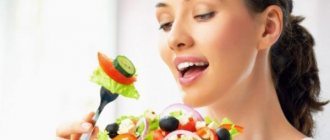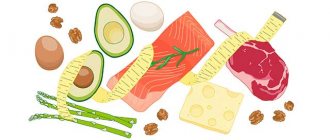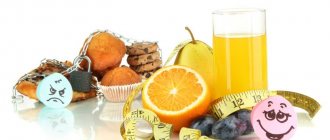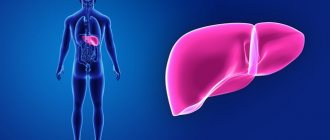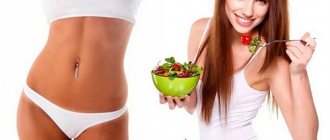From 12 to 16 years of age, the child grows rapidly, during this period the endocrine glands are actively formed.
If a child did not eat properly before adolescence, then it will be difficult for him to change eating habits. And this threatens obesity and diseases of the digestive organs, joints, hormonal changes, and weakened immunity.
To avoid the problems described above, you need to correctly create a menu for teenage children.
They need increased amounts of calories and nutrients, as their growth and development processes accelerate.
But it is important to choose the right products so that the body is saturated with useful substances.
The importance of a healthy diet during adolescence
At the age of 12, a child is actively growing, so it is necessary to supplement the diet with foods rich in calcium. A deficiency of this substance threatens scoliosis or osteochondrosis, and the likelihood of frequent injuries and bone fractures increases.
From the age of 11, the endocrine glands actively develop. Children often develop acne at this age. To improve your skin condition, you need to reduce the amount of fatty foods and sweets in your diet. The child's menu should consist of vegetables, fruits (sources of fiber) and products made from whole grains (cereals).
An unhealthy or monotonous diet can cause the following problems:
- dizziness, “black spots” before the eyes;
- constant fatigue, even after minor work;
- weakened immunity;
- gradual destruction of hard dental tissues;
- joint pathologies;
- decreased bone mass, bone fragility;
- dysfunction of the genital organs in girls, irregular periods;
- decreased concentration and memory;
- excessive weight loss or weight gain.
Important! Most often, adolescent children suffer from diseases of the musculoskeletal system, digestive tract and metabolic disorders.
To avoid these problems, you need to properly plan your teenager’s diet.
Be sure to look: Rules and recipes for a menu for healthy eating Rules for compiling and an approximate menu for a week as part of proper nutrition The meaning and rules for drawing up a regime for healthy eating for a healthy person We create a menu for older people correctly: we take into account the characteristics of the body at 60 and 80 years old
The outcome of constant unhealthy diets
Poor nutrition in youth destroys bones in old age
The cause of joint diseases (arthrosis) in old age is a diet with insufficient calcium and vitamin D in childhood.
The likelihood of developing osteoporosis increases in adolescents who exhaust themselves with diets, especially in girls suffering from eating disorders. Girls are still at risk of bone tissue destruction, since at this age active growth and formation of the skeleton occurs, and prolonged fasting can negatively affect this process.
If a girl’s diet is varied and balanced, rich in calcium, protein and vitamin D, this will reduce the risk of osteoporosis in the future.
Delayed puberty
ZPR occurs with a lack of body weight (unbalanced diet, low calorie food, diet, fasting) or, conversely, with obesity. Delayed puberty can occur with intense sports activities if the teenager eats little.
Anorexia
One of the sad consequences of incorrect fanatical diets is anorexia, which turns the human body into a skeleton covered with skin. Usually girls who are dissatisfied with their appearance bring themselves to this state. First, diets appear, then refusal to eat at all, inducing vomiting, taking laxatives and diuretics.
Interesting to know. Anorexia is the most common mental illness of adolescence. 50% of girls think they are overweight. 80% of girls this age have already been on a diet at least once. 2–4% of girls suffer from anorexia. Anorexia ranks first in terms of mortality from mental illness.
What parents need to pay attention to if they suspect anorexia in their child:
- sudden weight loss within a month;
- weakness, fatigue, irritability;
- frequent mood changes;
- refusal to eat with family or friends;
- disappearance after a feast (monitor your child if you suspect that he is vomiting after eating);
- disruptions in the menstrual cycle, cessation of menstruation;
- obsession with appearance and nutrition;
- sleep disturbance;
- constant cold and chills;
- increased physical activity in the absence of adequate nutrition.
In addition to the outwardly terrifying appearance, anorexia causes problems with the functioning of the kidneys and gastrointestinal tract, osteoporosis and anemia develop, disruptions in the functioning of the heart and central nervous system may occur, and the mind also suffers.
Need for food
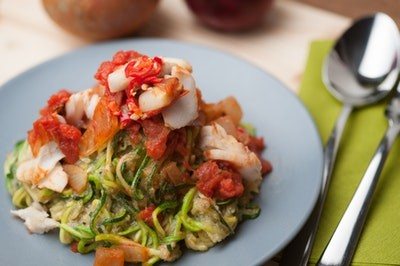
The energy metabolism of a 14-15 year old child differs from the catabolism of adults. A mature person consumes approximately 1 kcal/1 kg per hour during rest, and a teenager consumes 1.8 kcal.
Children in adolescence are active; they spend approximately 600 kcal per day on movement. Their bone and muscle tissue grows rapidly, which consumes from 60 to 100 kcal. The total energy expenditure of a teenager is from 2400 to 2500 kcal in 24 hours.
To satisfy the body's needs, as well as replenish energy reserves, a child should consume 2500-3000 kcal.
Attention! The daily amount of calories for a teenager who regularly plays sports is from 3100 to 3500 kcal.
In addition, you need to monitor the quality of the dishes. They should consist of proteins, fats, carbohydrates in the following ratio - 1:1:4. To ensure that the tissue building process is not disrupted, a teenager should receive up to 100 g of protein per day. Animal proteins (meat, poultry, fish) are preferable.
Important! A vegetarian diet is not suitable for all children, as there is a risk of iron deficiency anemia.
Guys should consume 100 g of fat, which provides energy and helps build cells. It is recommended to use vegetable oils, they improve the condition of the skin.
Carbohydrates are the main source of energy; a teenager should consume 400 g of nutrients per day.
You may also be interested in: Proper nutrition: menu for the week
Consumption standards for vitamins, macro- and microelements for a teenager

A teenager must receive the required amount of macro- and microelements and vitamins from food. In the summer, it is enough to eat a variety of fresh vegetables and fruits (berries), and in the winter-spring period you can take a course of vitamin preparations. It is believed that by eating six fruits of different colors a day, we meet the need for all the necessary vitamins and minerals!
Calcium (1.2 g/day) and magnesium (300 mg/day) are needed for building bones and teeth; magnesium also relieves the excitability of the nervous system, helps cope with insomnia, and has a beneficial effect on the heart muscle.
Phosphorus (1.8 g/day) is necessary for metabolism, normal functioning of the nervous system and brain, muscles, liver and kidneys.
Iron (15–18 mg/day) is necessary for hematopoiesis and saturation of the body with oxygen.
Sodium (4 g/day), chlorine and potassium (4 g/day) normalize water-salt metabolism, acid-base balance, potassium removes excess water and sodium from the body.
Iodine (130 mcg/day) is necessary for the normal functioning of the thyroid gland.
Fluoride (2–3 mg/day) is involved in the construction of bones and teeth.
Vitamins are needed for the normal course of metabolic processes and the functioning of the body as a whole. They participate in various biochemical processes, ensure the physical and mental performance of a teenager, and strengthen the immune system.
Daily vitamin intake for teenagers:
- A – 1.5 mg;
- B1 – 1.8 mg;
- B2 – 2.5 mg;
- B6 – 2.0 mg;
- B12 – 3.0 mcg;
- RR – 19 mg;
- C – 75 mg;
- E – 15 mg;
- D – 2.5 mg.
What products are needed
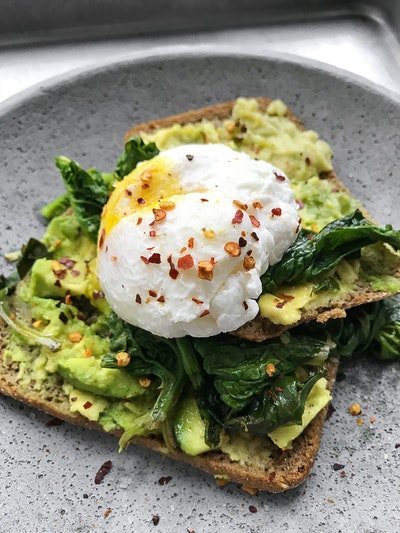
To ensure that development is not disrupted, the immune system is strengthened, and the period of hormonal changes passes easily, adolescents should consume the following foods:
- Protein foods include meat, fish (dietary varieties), beans, nuts, eggs, milk, low-fat dairy products. You can supplement this list with seafood. Protein foods accelerate muscle growth, strengthen them, and help burn excess fat;
- healthy fats: vegetable oils, salmon, tuna, trout, nuts. These products help develop, improve the condition of hair and skin;
Carefully! Teenagers should avoid unhealthy fats that negatively affect the cardiovascular system. It is better to give up whole milk, fatty meats, coconut and palm oil, confectionery products with rich cream, snack products, and fried foods.
- sources of complex carbohydrates: cereals, vegetables, whole grain bread, legumes, fruits, berries. They charge the body with energy. Simple carbohydrates (sweet pastries with fillings, sweets) are best avoided;
- milk and products made from it, low-fat cheeses, cabbage, nuts, seeds, rice, lentils, and broccoli saturate the body with calcium. This substance strengthens bone tissue, normalizes blood clotting, and increases stress resistance;
- Thanks to fish, seafood, beef, legumes, buckwheat, white cabbage, potatoes, spinach, the body is saturated with iron. This substance supports the growth of adolescents, replenishes blood loss in girls during menstruation;
- A lot of fiber is found in vegetables and fruits. Coarse fibers cleanse the body of waste and toxins, and thanks to antioxidants, protect cells from damage.
In addition, the child needs clean filtered water. The daily volume depends on weight (30 ml/1 kg).
How to teach your child to eat right
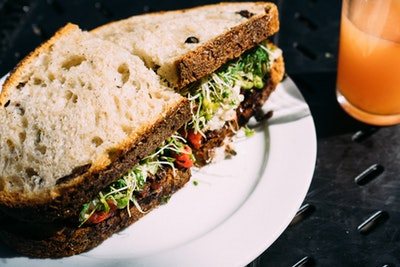
Teenagers often snack on the go and avoid family meals, which is bad for their health.
To encourage school-aged children to eat properly, you can use the following recommendations:
- If your child is a fan of any sport, then explain to him that a balanced diet will help him keep his body in great shape.
- Children aged 14-15 years often develop acne, their hair quickly becomes oily, which causes them complexes. Tell us that eating right will help you avoid this.
- Remind your teen that eating homemade food will save money.
- Always leave tasty, healthy food in the kitchen that your child likes.
- Invite him to join the family meal more often.
And most importantly, be an example for children. If they see that their parents eat right and look good, they will also strive for this (at least on a subconscious level).
The oldest myth about healthy eating

Soup is not a necessary dish in a healthy diet for a teenager! This phrase may surprise many. After all, we all remember how mom worried every day whether we had eaten soup today. Yes, this is a really good dish. Boiled meat, vegetables, liquid. However, you can just as easily eat a salad and wash it down with a glass of cold water. Moreover, soups are also different. There is nothing healthy at all in those rich, fatty soups that our grandmothers love to cook. Therefore, if your child likes soup and eats it with pleasure, it’s good for him, but if not, you shouldn’t force him.
Regime is important
A child from 11 to 14-15 years old should eat at least 4 times a day:
- Breakfast. During the first meal, he should consume up to 25% of the total calories.
- Dinner. The second meal is the largest - from 35 to 40% of all calories.
- An afternoon snack is a small snack that is equal to about 15% of daily calories.
- Dinner. The evening meal accounts for no more than 25% of the total calories.
Read more about organizing a proper diet for children and adults.
Attention! Evening meals should be planned 2 hours before bedtime.
How to create a healthy menu for every day with calorie calculations: recommendations for the week
When you plan your child's diet, take into account his daily routine.
The principles of creating a weekly menu with proper nutrition are simple. An approximate diet for each day can be oriented according to the table:
| Breakfast | Main course – 300 g, drink – 200 ml. Options: porridge with milk, cottage cheese or dishes made from it, omelet. You can supplement this food with vegetables, fresh or dry fruits, lean meat, and homemade sauce. |
| Dinner | 250 mg liquid food, 100 g vegetable salad, 300 g main dish, 200 ml drink. |
| Afternoon snack | Fermented milk products, fruits, cookies. The serving size is 100 g, you can wash it all down with 200 ml of drink. |
| Dinner | Main course – 300 g and 200 ml of drink. Examples of food: cottage cheese baked goods, egg or fish dishes, porridge with vegetables. |
Bread can be consumed during every meal. It is better to give preference to a whole grain product.
Important! The correct diet for a teenager should be based on calories. The daily calorie menu for girls is 2500 kcal, and for boys - 3000 kcal. Within 24 hours, children should consume 30% fat, 20% protein, 50% carbohydrates.
Cottage cheese casserole with pumpkin and dried apricots
Who doesn't love cottage cheese casserole? Many housewives know its recipe from their mothers and grandmothers. However, let's diversify this healthy recipe a little by adding pumpkin and dried fruits. The best combination with pumpkin is dried apricots. Casserole is an ideal option for a light and healthy dinner.
What we need for cooking:
- pumpkin – 200 g;
- cottage cheese – 300 g;
- eggs – 2 pcs.;
- dried apricots – 50 g;
- sour cream – 2 tbsp;
- water – 0.5 cups (100 ml),
- sugar - to taste, 2-3 tbsp. l. (if the child does not have a big sweet tooth, you can limit yourself to 1 tablespoon).
Cooking steps:
- Cut the pumpkin pulp into cubes and simmer in a thick-bottomed saucepan until soft.
- Mix cottage cheese with sour cream and beat thoroughly until smooth. Add dried apricots (pre-finely chopped), eggs and sugar to the mixture. Mix.
- When the pumpkin is cooked, you need to mash it to a puree-like consistency. Once cooled, add to the curd mixture.
- Distribute the cottage cheese-pumpkin mixture evenly in a buttered baking dish. Place in the oven at 180 degrees. Baking duration: 30 minutes (until a golden crust appears on the dish).
Features of a rational menu for excess weight

Daily calorie intake should be reduced by 10-20%. In addition, the teenager must do physical exercise.
If you are obese, it is better to eat at home; the main part of the diet is boiled, stewed, steamed, baked (without oil) food. Replenish the menu with vegetable broth soups, water-based porridges, low-fat dairy products, dietary meat, fish, and egg whites.
You should limit the amount of potatoes, pasta (class A), and sweets. They can be included in the menu no more than 2 times in 7 days.
To lose weight faster, you need to exercise at least 2 times a week for 1-2 hours. This could be running, cycling, gymnastics, etc. For more information, see the article about recommended exercises for losing weight for a teenager.
You may also be interested in: Selecting a menu for proper nutrition for a student
Doctors' advice

According to qualified doctors, children in adolescence need proteins, minerals, and vitamins. These substances support normal growth, accelerate the formation of the musculoskeletal system, and promote brain development. To avoid metabolic disorders or obesity during sudden hormonal changes, you need to monitor the teenager’s diet.
Murashko Ekaterina, nutritionist
A teenager should eat a variety of foods made from animal or plant products. The amount of carbohydrate food should exceed 4 times the amount of proteins and fats. The best sources of proteins: turkey, fish, milk, cottage cheese, nuts, legumes, etc.
Children 14-15 years old are recommended to consume cream, sour cream, and vegetable oils. Sources of carbohydrates: sugar, whole grain bread, class A pasta, potatoes, vegetables, fruits, berries. Fast carbohydrates instantly charge you with energy, but after 2 hours the child will be hungry, and concentration and memory will decrease.
Important! It is better to exclude confectionery products containing palm and coconut oil from the diet. You can replace them with homemade baked goods, which are allowed to be consumed no more than once a week.
It is recommended to eat food 4-5 times a day with an interval of 3 hours. Lunch should be the most satisfying, and dinner should be light. In addition, do not forget about the drinking regime; the child should drink at least 1 liter of water per day.
Selezneva Ksenia, nutritionist

The nutritionist claims that proper, rational nutrition for adolescents is a necessary condition for ensuring their health, beauty and educational success.
To attract children to healthy eating, K. Selezneva advises organizing family dinners more often, organizing them together. If there are products on the table that are harmful to children, then draw the child’s attention to their composition. As a rule, food additives are present in the first rows on the label. To learn about their health effects, search for information on the Internet. Perhaps after this the child will refuse to consume them.
Protein products are more suitable for a healthy breakfast with proper nutrition, and dairy-vegetable foods are more suitable for dinner. Replenish your diet with greens and vegetables.
Instead of the usual side dish (potatoes and pasta), you can serve porridge, which contains minerals, fiber, and vitamins.
By following these rules, you will soon notice that the child has become stronger, more energetic, and is better able to assimilate educational material.
Pyzhik Alla, nutritionist
A doctor of the first category with 19 years of experience believes that children in the prepubertal period should consume proteins (animal and vegetable), since they are structural elements for every cell of the body. Eggs, dietary meat, and fish are important foods for teenagers.
The doctor advises you to opt for small fish (mackerel, herring). This is due to the fact that large fish often accumulate salts of heavy metals, and the system of cleansing the body of toxins at this age is still unstable. Small fish are rich in Omega-3 fatty acids, which have a beneficial effect on the heart and memory.
In addition, the child’s menu should be supplemented with buckwheat, oatmeal, quinoa, green peas, lentils, peas and other sources of fiber and valuable fats.
Fruits, vegetables, and berries are used as sources of vitamins.
Baked fish with vegetables
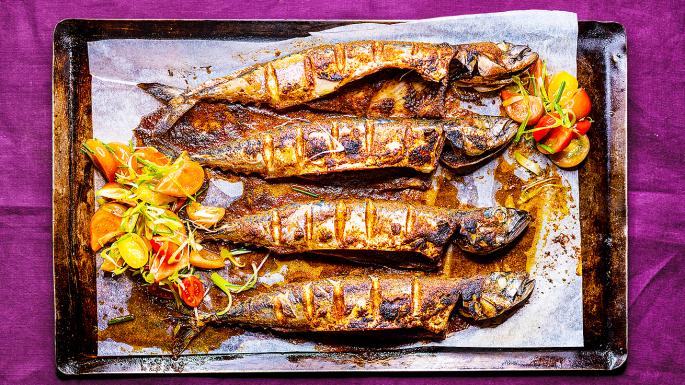
Unfortunately, it is often quite difficult to get teenagers to eat fish. However, it is a truly necessary product in the diet, being the main source of phosphorus. Below is a recipe for a delicious fish dish for a teenager.
What we need for cooking:
- sea fish (ideally mackerel or pink salmon);
- hard cheese – 100 g (salted farm cheeses are considered the healthiest, as they do not contain vegetable fats);
- carrots – 1 pc.;
- onion – 1 pc.;
- lemon - a few slices.
Cooking steps:
- Clean the fish thoroughly and cut off the head. Rub the cleaned carcass with salt.
- Chop the onion, grate the carrots and cheese, mix and add salt to taste.
- Cut the fish lengthwise from one edge, but not completely, but so that the second edge remains unaffected. Stuff the fish with vegetables and cheese. Also place lemon slices inside; they will soak the filling and fish so that it does not dry out in the oven.
- Wrap the dish in foil and place in an oven preheated to 220 degrees for 40 minutes.

